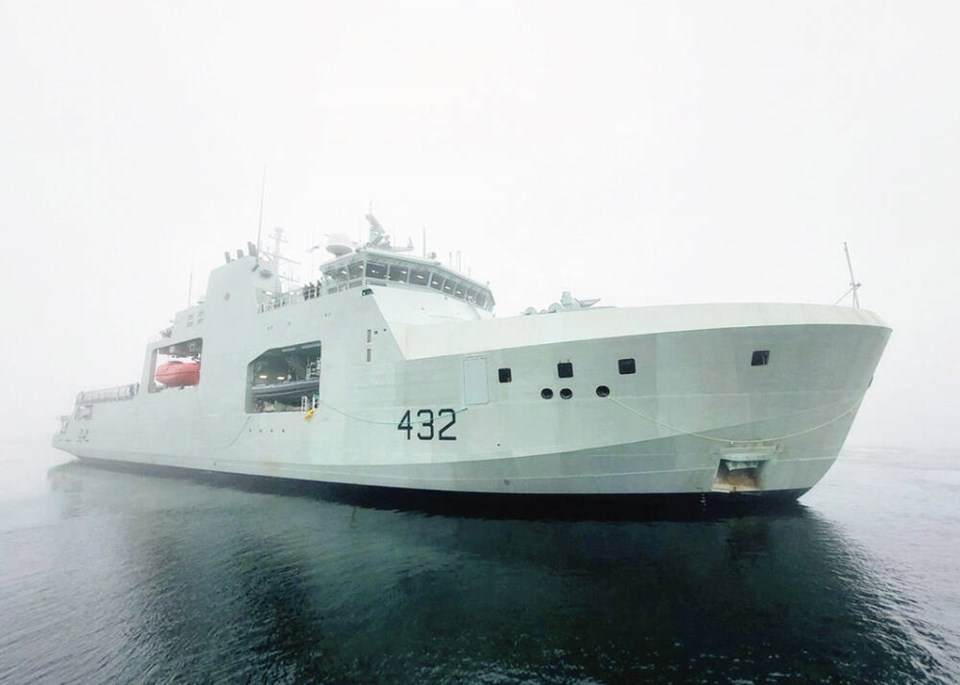The first of a new era of ships for the Royal Canadian Navy is arriving on the West Coast next week.
HMCS Max Bernays left Halifax on March 11, made its way through the Panama Canal and is heading north from San Francisco for arrival at CFB Esquimalt on Monday about 10:30 a.m. The ship has a blended crew of about 70 from CFB Halifax and CFB Esquimalt.
Named after a hero of the Second World War, the Max Bernays is an Arctic and offshore patrol vessel designed to assert Canadian sovereignty in the Arctic’s Northwest Passage and on the West Coast, and to support international operations.
Four of the new Harry DeWolf-class vessels were built at Irving Shipyards in Halifax and are operational while another two are under construction.
CFB Esquimalt will be home port for two of the vessels — the Max Bernays and the Robert Hampton Gray, currently being built in Halifax, said Sub-Lt. Simon Gonsalves.
He said the DeWolf-class ships differ from the navy’s frigates in look and capabilities. They are each 103 metres long with a top speed of 31 km/h (17 knots), a range of 6,800 nautical miles and a crew of up to 85. The class has ice-breaking plating and special design features for operation in drastically different environments — from Arctic to tropical waters — and the ability to provide rapid mobility to navy and other Canadian Armed Forces personnel.
The navy said the class is able to conduct armed presence and surveillance operations, contribute to humanitarian assistance, emergency response and disaster relief both domestically and internationally, and conduct search and rescue missions.
The enclosed fo’c’sle — the foremost part of the upper deck — and cable deck protect foredeck machinery and personnel work spaces from the Arctic environment. The stern is able to accommodate payloads such as shipping containers, underwater survey equipment or landing craft. The ship is equipped with a 20-tonne crane, providing self-load and unload capabilities.
It has a bay large enough to carry specialized vehicles such as pickup trucks, ATVs and snowmobiles, providing rapid mobility to transport personnel over land or ice.
Two 4.5-megawatt main propulsion engines power the ships, and bow thrusters provide increased maneuverability, allowing berthing without assistance from tugboats.
Retractable fin stabilizers can be deployed to reduce ship roll in open ocean operations, and can be retracted for operations in ice. Depending on mission requirements, the ships are able to accommodate aircraft ranging from small utility aircraft up to the CH-148 Cyclone maritime helicopter.
The class has a BAE 25mm Mk 38 machine gun system with gun targeting and surveillance system, as well as the M242 cannon.
HMCS Max Bernays was launched on Oct. 23, 2021, and a naming ceremony was held the following May.
Chief Petty Officer Max Bernays, a Vancouver native, served as the coxswain on HMCS Assiniboine during the Battle of the Atlantic.
On Aug. 6, 1942, during intense surface gun action against German submarine U-210, the Assiniboine manoeuvred in and out of fog attempting to ram and sink the enemy submarine. Both vessels were firing high-explosive shells at close range, resulting in a fire that engulfed the bridge and wheelhouse of Assiniboine. Surrounded by smoke and flames while steering the ship, Bernays ordered two junior sailors to get clear, leaving him alone at the helm and trapped by the blaze.
Surrounded by flames, he executed all the helm orders as Assiniboine manoeuvred for position against the U-boat, and did the work of the two telegraph men, dispatching more than 130 orders to the engine room. Several bullets and shells penetrated the wheelhouse as the enemy concentrated their machine-gun and cannon fire on the bridge.
Eventually Assiniboine rammed and sank U-210 in what was considered to be an extremely hard-fought action, during which the Canadians suffered one fatality and 13 wounded.
On the German side, 38 of the 48 crew were rescued.
Bernays was awarded the Conspicuous Gallantry Medal for his courage and devotion to duty during the battle. He was one of only two members of the Royal Canadian Navy to receive the medal during the Second World War.
He survived and went on to serve in Korea. He died in 1974 at age 64. His medals are on display at CFB Esquimalt.
The six new Arctic and offshore patrol vessels have all been named after Canadian naval heroes.
The lead ship was named HMCS Harry DeWolf. The other ships in the class are named Margaret Brooke, William Hall, Frédérick Rolette and Robert Hampton Gray, who grew up in Trail and Nelson. He was a navy officer and pilot and the recipient of the Victoria Cross.
>>> To comment on this article, write a letter to the editor: [email protected]




